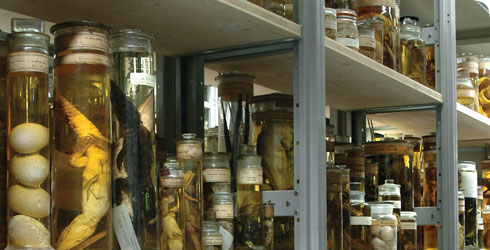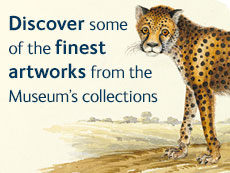Introduction to our collections
The Natural History Museum is home to the largest and most important natural history collection in the world, with 80 million specimens, ranging from microscopic slides to mammoth skeletons. But what do we gain from this vast and growing collection, and what does the future hold for this impressive data source?
Helping us to solve problems and learn about our world
Gathered over the last 400 years, and ranging in age from the origins of the solar system to the present day, the Museum’s collections are a window to both the past and future.
They are helping scientists to trace the history of the solar system and the evolution of life on Earth. They can tell us how the world might have looked when dinosaurs roamed the Earth, and can help us monitor the changing environment and its effect on the planet. Scientists also use the collections to understand everyday problems with farming and disease.
And as the most important records of natural history available in the world today, used by scientists all over the world, they are a source of boundless inspiration and wonder.
What's in the collections?
The Museum's vast collections comprise specimens from across the natural world, including items from the voyages of discovery by Darwin and Cook, material from the ill-fated dodo and meteorites from Mars. They cover virtually all groups of animals, plants, minerals and fossils, and include skins, cells on slides and whole animals preserved in alcohol.
In total there are…
- 61.5 million animal specimens, including 34 million insects
- 7 million fossils, with the oldest dating back more than 3,500 million years
- 6 million algae, lichens and plants, 10 per cent of which come from the British Isles
- 500,000 rocks, gems and minerals, of which 5,000 are meteorites
Natural history library
The Museum also houses the world's finest natural history library. It is the largest collection of natural history library materials in the world and includes…
- more than 750,000 printed books
- 25,000 periodical titles
- 350,000 original drawings, paintings and prints. This is the third largest collection of art in the UK.
- 10,000 manuscripts
- 75,000 maps
Type specimens
More than 850,000 type specimens are present in the Museum's collections. Type specimens are of great value as they are the unique representative of a species and the first specimen to earn the species name. Whenever the species comes under review, scientists will refer to the type for answers.
Modern collections
Technological advancements have meant that as well as traditional collections, the Museum is also home to cell and tissue cultures, DNA banks and other molecular records. These provide taxonomists with the means to conserve and study the genetic biology of plants and animals.


